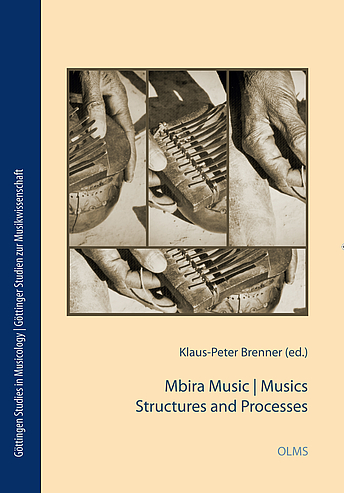Brenner
Mbira Music | Musics
ISBN 978-3-487-15842-6
Mbira Music Musics. Structures and Processes presents a collection of special studies focussing on some of the many typologically and genetically interrelated lamellophones and the respective web of musical idioms and 'dialects' whose historically dynamic distribution covers the vast south-central African area of what are now the Shona-speaking parts of Zimbabwe and adjacent areas in Zambia, Malawi, Mozambique, and South Africa. Besides deepening specific aspects of and exploring amazing new developments branching out from the already well-documented Zezuru mbira dzavadzimu and the Kwanongoma College’s, now widespread, schools version of the karimba, these studies also highlight some of the previously underrepresented members of the south-central African lamellophone family such as the Tonga kankobela, the Lala kankobele, the Korekore and Sena-Nyungwe matepe, and the particularly variable and idiosyncratic Ndau mbira dza-VaNdau. Special emphasis is laid on in-depth analyses of the intricately systemic nexus between their organology, their playing techniques and the cognitive dimension, aesthetics, function and symbolism of their respective musical repertoires, as well as on the 'biology' of those repertoires as embodied knowledge transmitted aurally/visually within dynamic networks of players. Significant recent innovations which are analyzed here include the extension, hybridization and triple-combination of different tuning plans into a single large-ambitus solo instrument, the emergence of, again large-ambitus, 'mbira orchestras' created by means of a staggered extension and modally shifted reorganization of the traditional ensemble structure and musical material (however, at the cost of blurring the identity of individual pieces and undermining their religious function), as well as perhaps the utmost possible extension of improvisational spaces within the otherwise unchallenged grammatical framework of an individual mbira piece. The present volume pools contributions of fourteen African, American and European scholars and musicians from Zimbabwe, South Africa, the United States, the Netherlands, Austria and Germany. An extensive collection of audio, video and graphic companion material is provided online. The editor is a lecturer at the Department of Musicology and the curator of the Collection of Musical Instruments at the University of Göttingen, Germany.ingen, Germany
Mbira-Musik Musics. Structures and Processes präsentiert eine Sammlung von Spezialstudien, die sich auf einige der vielen typologisch und genetisch miteinander verbundenen Lamellophone und das entsprechende Netz von musikalischen Idiomen und "Dialekten" konzentrieren, deren historisch dynamische Verbreitung das riesige süd-zentralafrikanische Gebiet der heute Shona-sprachigen Teile Simbabwes und der angrenzenden Gebiete in Sambia, Malawi, Mosambik und Südafrika umfasst. Neben der Vertiefung spezifischer Aspekte und der Erkundung erstaunlicher neuer Entwicklungen, die sich von der bereits gut dokumentierten Zezuru mbira dzavadzimu und der inzwischen weit verbreiteten Schulversion der Karimba des Kwanongoma College ableiten, beleuchten diese Studien auch einige der bisher unterrepräsentierten Mitglieder der süd-zentralafrikanischen lamellophonen Familie wie die Tonga kankobela, die Lala kankobele, die Korekore und Sena-Nyungwe matepe sowie die besonders variable und eigenwillige Ndau mbira dza-VaNdau. Ein besonderer Schwerpunkt liegt auf der eingehenden Analyse der komplexen systemischen Verbindung zwischen ihrer Organologie, ihren Spieltechniken und der kognitiven Dimension, der Ästhetik, der Funktion und der Symbolik ihres jeweiligen musikalischen Repertoires sowie auf der "Biologie" dieser Repertoires als verkörpertem Wissen, das innerhalb dynamischer Netzwerke von Spielern auditiv/visuell weitergegeben wird. Zu den bedeutenden Neuerungen der letzten Zeit, die hier analysiert werden, gehören die Erweiterung, Hybridisierung und Dreifachkombination verschiedener Stimmschemata in einem einzigen Großambitus-Soloinstrument, die Entstehung von - ebenfalls großambitischen - "Mbira-Orchestern", die durch eine gestaffelte Erweiterung und modal verschobene Reorganisation der traditionellen Ensemblestruktur und des musikalischen Materials entstanden sind (allerdings um den Preis der Verwischung der Identität der einzelnen Stücke und der Untergrabung ihrer religiösen Funktion), sowie die vielleicht größtmögliche Erweiterung der Improvisationsräume innerhalb des ansonsten unangefochtenen grammatikalischen Rahmens eines einzelnen Mbira-Stücks. Der vorliegende Band vereint Beiträge von vierzehn afrikanischen, amerikanischen und europäischen Wissenschaftlern und Musikern aus Simbabwe, Südafrika, den Vereinigten Staaten, den Niederlanden, Österreich und Deutschland. Eine umfangreiche Sammlung von Audio-, Video- und Grafikmaterial ist online verfügbar. Die Herausgeberin ist Dozentin am Institut für Musikwissenschaft und Kuratorin der Musikinstrumentensammlung der Universität Göttingen, Deutschland.


